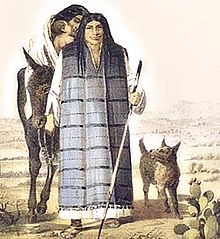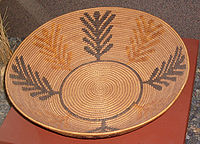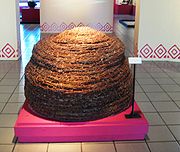
Kumeyaay
Encyclopedia
The Kumeyaay, also known as Tipai-Ipai, Kamia, or formerly Diegueño, are Native American
people of the extreme southwestern United States
and northwest Mexico
. They live in the states of California
in the US and Baja California
in Mexico. In Spanish, the name is commonly spelled Kumiai.
: the northern Ipai (extending from Escondido
to Lake Henshaw) and the southern Tipai (including the Laguna Mountains
, Ensenada
, and Tecate
).
, Kumeyaay proper
(including the Kamia), and Tipai
in northern Baja California (e.g., Langdon 1990). However, this notion is not supported by speakers of the language (actual Kumeyaay people) who contend that within their territory, all Kumeyaay (Ipai/Tipai) can understand and speak to each other, at least after a brief acclimatization period. All three languages belong to the Delta–California branch of the Yuman family, to which several other linguistically distinct but related groups also belong, including the Cocopa
, Quechan
, Paipai
, and Kiliwa
.
The meaning of the term Kumeyaay is unknown, but Ipai or Tipai both mean "people." Some Kumeyaay in the southern areas also refer to themselves as MuttTipi, which means "people of the earth."
 Evidence of human settlement in Kumeyaay territory goes back at least 12,000 years. 7000 BCE marked the emergence of two cultural traditions: the California Coast and Valley tradition and the Desert tradition. The Cuyamaca complex
Evidence of human settlement in Kumeyaay territory goes back at least 12,000 years. 7000 BCE marked the emergence of two cultural traditions: the California Coast and Valley tradition and the Desert tradition. The Cuyamaca complex
, a late Holocene
complex in San Diego County is related to the Kumeyaay peoples.
Historic Tipai-Ipai emerged around 1000 CE; however, others say that Kumeyaay people have lived in San Diego for 12,000 years. At the time of European contact, Kumeyaay comprised several autonomous bands with 30 patrilineal, clans.
Spaniards entered Tipai-Ipai territory in the late 18th century, bringing with them non-native, invasive weeds, and domestic animals, which causes dramatic changes to the local environment. Under the Spanish Mission system, bands living near Mission San Diego de Alcalá
, established in 1769, were called Diegueños. After Mexico took over the lands from Spain, they secularized the missions in 1834, and Ipai and Tipais lost their lands and essentially became serf
s.
From 1870 to 1910, American settlers seized the best farming and grazing lands. In 1875, President Ulysses Grant created reservations in the area, and additional lands were placed under trust patent status after the passage of the 1891 Act for the Relief of Mission Indians. The reservations tended to be small and lack adequate water supplies.
Kumeyaay people supported themselves by farming and agricultural wage labor; however, 20-year drought in the mid-20 century crippled the region's dry farming economy. For their common welfare, several reservations formed the non-profit Kumeyaay, Inc.
proposed that the population of the Kumeyaay in 1770, exclusive of those in Baja California, had been about 3,000. Katharine Luomala suggested that the region could have supported 6,000-9,000 Kumeyaay. Florence C. Shipek went much farther, estimating 16,000-19,000 inhabitants.
In the late 18th century, Kumeyaay population was between 3000 and 9000. In 1828, 1711 Kumeyaay were recorded by the missions. The 1860 federally census recorded 1571 Kumeyaay living in 24 villages. In 1900, an estimated 1200 Kumeyaay lived on reservation lands, while 2000 lived elsewhere. The Bureau of Indian Affairs recorded 1322 Kumeyaay in 1968, with 435 living on reservations.

 The Kumeyaay live on 13 reservations in San Diego County, California
The Kumeyaay live on 13 reservations in San Diego County, California
in the United States and are enrolled in the following federally recognized tribes:
They live on five communities in Baja California
, including:
Native Americans in the United States
Native Americans in the United States are the indigenous peoples in North America within the boundaries of the present-day continental United States, parts of Alaska, and the island state of Hawaii. They are composed of numerous, distinct tribes, states, and ethnic groups, many of which survive as...
people of the extreme southwestern United States
United States
The United States of America is a federal constitutional republic comprising fifty states and a federal district...
and northwest Mexico
Mexico
The United Mexican States , commonly known as Mexico , is a federal constitutional republic in North America. It is bordered on the north by the United States; on the south and west by the Pacific Ocean; on the southeast by Guatemala, Belize, and the Caribbean Sea; and on the east by the Gulf of...
. They live in the states of California
California
California is a state located on the West Coast of the United States. It is by far the most populous U.S. state, and the third-largest by land area...
in the US and Baja California
Baja California
Baja California officially Estado Libre y Soberano de Baja California is one of the 31 states which, with the Federal District, comprise the 32 Federal Entities of Mexico. It is both the northernmost and westernmost state of Mexico. Before becoming a state in 1953, the area was known as the North...
in Mexico. In Spanish, the name is commonly spelled Kumiai.
Subgroups
The Kumeyaay consist of two related groups, the Ipai and Tipai. The two coastal groups' traditional homelands were approximately separated by the San Diego RiverSan Diego River
The San Diego River is a river in San Diego County, California. It originates in the Cuyamaca Mountains northwest of the town of Julian, then flows to the southwest until it reaches the El Capitan Reservoir, the largest reservoir in the river's watershed at . Below El Capitan Dam, the river runs...
: the northern Ipai (extending from Escondido
Escondido, California
Escondido is a city occupying a shallow valley ringed by rocky hills, just north of the city of San Diego, California. Founded in 1888, it is one of the oldest cities in San Diego County. The city had a population of 143,911 at the 2010 census. Its municipal government set itself an operating...
to Lake Henshaw) and the southern Tipai (including the Laguna Mountains
Laguna Mountains
The Laguna Mountains are a section of the Peninsular Ranges in eastern San Diego County, California. The mountains run in a northwest/southeast alignment for approximately ....
, Ensenada
Ensenada, Baja California
Ensenada is a coastal city in Mexico and the third-largest city in Baja California. It is located south of San Diego on the Baja California Peninsula. The city is locally referred to as La Cenicienta del Pacífico, or, The Cinderella of the Pacific...
, and Tecate
Tecate
Tecate is a small city in Baja California, Mexico and the municipal seat of Tecate Municipality. It is located on the border with Tecate, California, United States in the San Diego–Tijuana metropolitan area. There is a small port of entry betwixt the sister cities that serves as a calmer...
).
Language
Nomenclature and tribal distinctions are not widely agreed upon. The general scholarly consensus recognizes three separate languages: IpaiIpai language
Ipai, also known as Iipay or Northern Diegueño, is the Native American language spoken by the Kumeyaay people of central San Diego County, California. Hinton suggested a conservative estimate of 25 surviving Ipai speakers....
, Kumeyaay proper
Kumeyaay language
Kumeyaay , also known as Central Diegueño, Kamia, and Campo, is the Native American language spoken by the Kumeyaay people of southern San Diego and Imperial counties in California. Hinton suggested a conservative estimate of 50 surviving Kumeyaay speakers...
(including the Kamia), and Tipai
Tipai language
Tipai is the spelling used by anthropologists and people in Spanish-speaking countries to refer to Tiipay, a Native American language spoken by a number of Kumeyaay or Kumiai groups in northern Baja California and southern San Diego County, California. Tipai is also known as Southern Diegueño...
in northern Baja California (e.g., Langdon 1990). However, this notion is not supported by speakers of the language (actual Kumeyaay people) who contend that within their territory, all Kumeyaay (Ipai/Tipai) can understand and speak to each other, at least after a brief acclimatization period. All three languages belong to the Delta–California branch of the Yuman family, to which several other linguistically distinct but related groups also belong, including the Cocopa
Cocopa
The Cocopah or Cocopa are Native American people who live in Baja California and Sonora, Mexico, and in Arizona in the United States. The Cocopah language belongs to the Delta–California branch of the Yuman family. In Spanish, the Cocopah are termed Cucapá...
, Quechan
Quechan
The Quechan are a Native American tribe who live on the Fort Yuma Indian Reservation on the lower Colorado River in Arizona and California just north of the border with Mexico...
, Paipai
Paipai
The Paipai are an aboriginal people of northern Baja California, Mexico. They occupied a territory lying between the Kiliwa on the south and the Kumeyaay and Cocopa on the north, and extending from San Vicente near the Pacific coast nearly to the Colorado River's delta in the east...
, and Kiliwa
Kiliwa
The Kiliwa are an aboriginal people of northern Baja California, Mexico. They occupied a territory lying between the Cochimí on the south and the Paipai on the north, and extending from San Felipe on the Gulf of California to San Quintín on the Pacific coast...
.
The meaning of the term Kumeyaay is unknown, but Ipai or Tipai both mean "people." Some Kumeyaay in the southern areas also refer to themselves as MuttTipi, which means "people of the earth."
History

Cuyamaca Complex
The Cuyamaca complex is a precolumbian complex, dating from the late Holocene, with archaeological sites in San Diego County, California. This complex is related to the Kumeyaay peoples....
, a late Holocene
Holocene
The Holocene is a geological epoch which began at the end of the Pleistocene and continues to the present. The Holocene is part of the Quaternary period. Its name comes from the Greek words and , meaning "entirely recent"...
complex in San Diego County is related to the Kumeyaay peoples.
Historic Tipai-Ipai emerged around 1000 CE; however, others say that Kumeyaay people have lived in San Diego for 12,000 years. At the time of European contact, Kumeyaay comprised several autonomous bands with 30 patrilineal, clans.
Spaniards entered Tipai-Ipai territory in the late 18th century, bringing with them non-native, invasive weeds, and domestic animals, which causes dramatic changes to the local environment. Under the Spanish Mission system, bands living near Mission San Diego de Alcalá
Mission San Diego de Alcalá
Mission Basilica San Diego de Alcalá, in San Diego, California, was the first Franciscan mission in the Las Californias Province of the Viceroyalty of New Spain. It was founded in 1769 by Spanish friar Junípero Serra in an area long inhabited by the Kumeyaay Indians...
, established in 1769, were called Diegueños. After Mexico took over the lands from Spain, they secularized the missions in 1834, and Ipai and Tipais lost their lands and essentially became serf
SERF
A spin exchange relaxation-free magnetometer is a type of magnetometer developed at Princeton University in the early 2000s. SERF magnetometers measure magnetic fields by using lasers to detect the interaction between alkali metal atoms in a vapor and the magnetic field.The name for the technique...
s.
From 1870 to 1910, American settlers seized the best farming and grazing lands. In 1875, President Ulysses Grant created reservations in the area, and additional lands were placed under trust patent status after the passage of the 1891 Act for the Relief of Mission Indians. The reservations tended to be small and lack adequate water supplies.
Kumeyaay people supported themselves by farming and agricultural wage labor; however, 20-year drought in the mid-20 century crippled the region's dry farming economy. For their common welfare, several reservations formed the non-profit Kumeyaay, Inc.
Population
Estimates for the pre-contact populations of most native groups in California have varied substantially. Alfred L. KroeberAlfred L. Kroeber
Alfred Louis Kroeber was an American anthropologist. He was the first professor appointed to the Department of Anthropology at the University of California, Berkeley, and played an integral role in the early days of its Museum of Anthropology, where he served as director from 1909 through...
proposed that the population of the Kumeyaay in 1770, exclusive of those in Baja California, had been about 3,000. Katharine Luomala suggested that the region could have supported 6,000-9,000 Kumeyaay. Florence C. Shipek went much farther, estimating 16,000-19,000 inhabitants.
In the late 18th century, Kumeyaay population was between 3000 and 9000. In 1828, 1711 Kumeyaay were recorded by the missions. The 1860 federally census recorded 1571 Kumeyaay living in 24 villages. In 1900, an estimated 1200 Kumeyaay lived on reservation lands, while 2000 lived elsewhere. The Bureau of Indian Affairs recorded 1322 Kumeyaay in 1968, with 435 living on reservations.
Tribes and reservations


San Diego County, California
San Diego County is a large county located in the southwestern corner of the US state of California. Hence, San Diego County is also located in the southwestern corner of the 48 contiguous United States. Its county seat and largest city is San Diego. Its population was about 2,813,835 in the 2000...
in the United States and are enrolled in the following federally recognized tribes:
- Campo Band of Diegueno Mission Indians of the Campo Indian Reservation
- Capitan Grande Band of Diegueno Mission Indians of California:
- Barona Group of Capitan Grande Band of Mission Indians of the Barona Reservation
- Viejas (Baron Long) Group of Capitan Grande Band of Mission Indians of the Viejas Reservation
- Ewiiaapaayp Band of Kumeyaay IndiansEwiiaapaayp Band of Kumeyaay IndiansThe Ewiiaapaayp Band of Kumeyaay Indians, formerly known as the Cuyapaipe Community of Diegueno Mission Indians of the Cuyapaipe Reservation, is a federally recognized tribe of Kumeyaay Indians, who are sometimes known as Mission Indians...
-
- (formerly the Cuyapaipe Community of Diegueno Mission Indians of the Cuyapaipe Reservation)
- Inaja Band of Diegueno Mission Indians of the Inaja and Cosmit Reservation
- Jamul Indian Village of California
- La Posta Band of Diegueno Mission Indians of the La Posta Indian Reservation
- Manzanita Band of Diegueno Mission Indians of the Manzanita Reservation
- Mesa Grande Band of Diegueno Mission Indians of the Mesa Grande Reservation
- San Pasqual Band of Diegueno Mission Indians of California
- Santa Ysabel Band of Diegueno Mission Indians of the Santa Ysabel Reservation
- Sycuan Band of the Kumeyaay NationSycuan Band of the Kumeyaay NationThe Sycuan Band of the Kumeyaay Nation is a federally recognized tribe of Mission Indians from Southern California, near the El Cajon. The Sycuan band are a Kumeyaay tribe, one of the four ethnic groups indigenous to San Diego County....
- (formerly the Cuyapaipe Community of Diegueno Mission Indians of the Cuyapaipe Reservation)
They live on five communities in Baja California
Baja California
Baja California officially Estado Libre y Soberano de Baja California is one of the 31 states which, with the Federal District, comprise the 32 Federal Entities of Mexico. It is both the northernmost and westernmost state of Mexico. Before becoming a state in 1953, the area was known as the North...
, including:
- Juntas de Neji
- La Huerta
- San Antonio Necua
- Santa Catarina
- San José de la Zorra.
See also
- Kumeyaay traditional narrativesKumeyaay traditional narrativesKumeyaay traditional narratives include myths, legends, tales, and oral histories preserved by the Kumeyaay people of southern California and northwestern Baja California....
- O. M. WozencraftO. M. WozencraftOliver M. Wozencraft was a prominent early American settler in California. He had substantial involvement in negotiating treaties between California Native American Indian tribes and the United States of America...
negotiated the Treaty of Santa Ysabel on January 7, 1852. - Sycuan Institute on Tribal GamingSycuan Institute on Tribal GamingThe Sycuan Institute on Tribal Gaming at San Diego State University focuses on research, policy studies, and education related to the area of tribal gaming management...
at San Diego State University - Viejas Arena at San Diego State UniversitySan Diego State UniversitySan Diego State University , founded in 1897 as San Diego Normal School, is the largest and oldest higher education facility in the greater San Diego area , and is part of the California State University system...
- Viejas casino
Further reading
- Du Bois, Constance Goddard. 1904-1906. Mythology of the Mission Indians: The Mythology of the Luiseño and Diegueño Indians of Southern California. The Journal of the American Folk-Lore Society, Vol. XVII, No. LXVI. p. 185-8 [1904]; Vol. XIX. No. LXXII pp. 52–60 and LXXIII. pp. 145–64. [1906].
- Langdon, Margaret. 1990. "Diegueño: how many languages?" In Proceedings of the 1990 Hokan-Penutian Languages Workshop, edited by James E. Redden, pp. 184–190. University of Southern Illinois, Carbondale.
External links
- Kumeyaay Information Village, with educational materials for teachers
- Kumeyaay.com, information website of Larry Banegas, Barona Reservation
- Kumeyaay Indian Language
- Mythology of the Mission Indians, by Du Bois, 1904-1906.
- Religious Practices of the Diegueño Indians, by T.T. Waterman, 1910.
- Kumeyaay (Diegueño) language overview at the Survey of California and Other Indian LanguagesSurvey of California and Other Indian LanguagesThe Survey of California and Other Indian Languages at the University of California at Berkeley documents, catalogs, and archives the indigenous languages of the Americas...

